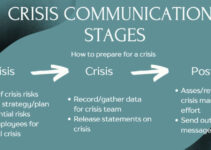Change management is the process of planning, setting up processes, and employing tools to implement organizational changes; guiding employees to adopt changes. It is necessary to guide and communicate with employees and team members during the transitional phase and direct them where you want them to be. Change management processes would help companies to decrease the risk of change. Today, we’ll discuss communication in change management process; stages of change management processes; communication strategy for every stage.
Role of communication in change management
- Making employees comprehend the reasons for change
- Decrease the employee resistance
- Provide a support network for the change project
- Clarify rumors and the atmosphere of distrust
- Improving the morale and confidence of employees
Communication practices in change management
- Employing multiple channels to approach employees
- Sharing the right information with the right audience
- Top management and leadership deliver the change message
- Recognize the target audience and connect with them
- Gather feedback and communicate regularly
- Commitment to openness and transparency
Communication in Change Management Process
Let’s discuss the communication in change management process; the different stages of change process and communication strategy for every stage as follows;
Starting Change Project
In order to achieve optimum progress and growth, the company introduces the change program and defines the future state of the company. The managers spread the change awareness about the upcoming changes. Since the changes are new, they’re cautious and fearful of the changes.
Communication Strategy: The focus of change managers and the company’s leadership is on spreading change awareness; while boosting the morale health and wellness of employees and team members. They employ promotional style communication and share the information in small bites; utilize multiple channels to approach the mass audience.
Medium: the best medium of communication is conducting education sessions and town hall meetings, and sending alert messages to all the employees.
Developing its Grounds
The leadership establishes the ground for the success of the change program by embedding the company’s change progress. The company clarifies the comprehensive understanding of the change project. However, employees are anxious and stressed about how changes would impact their roles and responsibilities. It is impacting their productivity and they’re resisting the changes.
Communication Strategy: the focus of change managers is building up their knowledge and awareness towards the change project and earning their commitment. They should engage in long and detailed communication to answer the questions.
Medium: the most useful medium is to engage in face-to-face conversation with supervisors, managers, and employees. The other channels are emails and newsletters to answer their questions in detail and send the relevant updated information.
Accelerating Progress
The management keeps speeding up and accelerating the change project towards completion, and their objective is to reduce the resistance of employees. They need to accept the changes as reality and show commitment toward changes. Employees and team members have a positive attitude towards changes and achieving positive results.
Communication Strategy: the focus of change managers is to manage the emotions of team members to retain the momentum and keep the resistance level low. They should employ positive reinforcement to deal with issues and resistance.
Medium: they should employ digital signage to reinforce the change message; and conduct a survey to know the emotions of employees. In order to regularly update employees, they should send desktop alert messages.
Completing the Changes
Finalizing and completing the changes, and they need to maintain the momentum to achieve the desired future state. The company needs to invest resources in the change project, and the employees should adopt the changes. However, employees are fully confident about learning the changes and it is improving their productivity.
Communication Strategy: the change managers should employ positive reinforcement, and celebrate small wins to achieve the support of employees. Recognize change champions and early adopters and use them to promote changes across the company.
Medium: The company’s leaders should break the news of success and the company has achieved its milestones.
Sustaining Changes
Embedding changes in the routine company’s operations to sustain the results. The change has achieved the desired future state, and the changes have become the new normal. Employees are happy and satisfied with the changes and support the new state of affairs.
Communication Strategy: the focus of change managers is to maintain the new processes and embed the post-changes in the company’s operations.
Medium: corporate screensaver is the best medium to celebrate wins and achievements. They should employ online surveys to analyze and monitor the emotions of employees at the end of the process.
Conclusion: Change Management Process and Communication Strategy | Communication For Change Management Process
After an in-depth study of the change management process and communication strategy; we have realized that different communication strategy required at every stage of change process. If you are learning about the communication strategy in change process, then you should keep in mind the abovementioned strategies, mediums, and stages of change process.
Ahsan is an accomplished researcher and has a deep insight in worldly life affairs. He goes Live 3 days a week on various social media platforms. Other than research writing, he’s a very interesting person.


